Message from the President

We aim to enhance corporate value
still further by taking on new fields of
business, continuing to increase profits,
and augmenting shareholder returns.
Takashi Tanaka
President, KDDI CORPORATION
August 2015
01. Ending the Second Year toward our Medium-Term Targets
KDDI is positioning the three-year period from the fiscal year ended March 31, 2014, to the fiscal year ending March 31, 2016, as a time of "full-scale income growth." As such, we have set the medium-term management target of achieving "double-digit growth in consolidated operating income."
The fiscal year ended March 31, 2015, was the second year for this medium-term management target, and during this time we concentrated on sustaining "au momentum" in the domestic mobile business. Furthermore, based on a policy of "targeting the next growth stage," we made steady inroads on new initiatives, such as launching "au WALLET" and commencing "telecommunications business in Myanmar".
On the performance front, an increase in mobile communications revenues and lower sales commissions absorbed higher up-front costs to invest in new businesses. As a result, consolidated operating income grew 11.8% year on year, to ¥741.3 billion, for our second consecutive year of doubledigit growth.
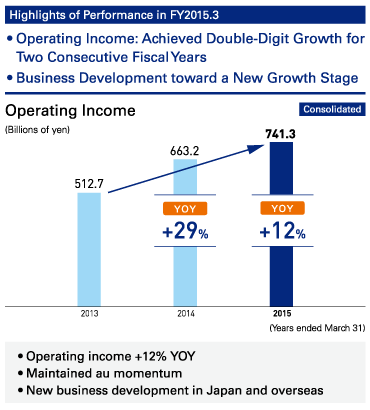
Reversal in au ARPU and Favorable au Net Additions for the Year
Our medium-term management target of achieving sustainable income growth hinges on increasing mobile communications revenues in the Personal Services segment, which accounts for more than 70% of consolidated operating revenues. During the first year of our medium-term management targets, the fiscal year ended March 31, 2014, the net increase in subscriber numbers was favorable, but au average revenue per unit (ARPU) trended downward for the fiscal year as a whole. Looking ahead to changes in the market environment, we made a commitment to turn au ARPU around in the fiscal year ended March 31, 2015.
Our introduction of the "Unlimited Voice & Tiered Data" rate plan, which had not been included in our initial expectations, caused revenues to drop, but a rise in the smartphone penetration rate led to robust increases in data ARPU. In addition, by controlling the amount of the "Maitsuki Discount (Monthly Discount)," we succeeded in turning around au ARPU for the fiscal year. As of March 31, 2015, KDDI's smartphone penetration rate was 54% (50% if limited to LTE). Going forward, we expect this rate to rise to more than 70%, commensurate with levels in the United States and South Korea.
Also, au net additions were favorable from the start of the fiscal year, and fourth-quarter results were particularly solid. During that three months, we recorded net additions of 1.1 million, bringing total net additions for the year to 2.96 million, up 5.1% from the fiscal year ended March 31, 2014.
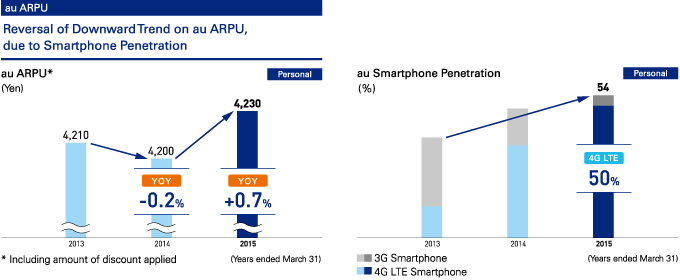

A Changing Environment for the Communications Industry
The Japanese communications market experienced a number of major changes in the fiscal year ended March 31, 2015.
First, NTT East and NTT West announced a shift to wholesaling fiber access service. Our competitors began offering discounts on bundled sets of mobile and fixed-line services.
Second was the announcement of new government guidelines on removing the subscriber identity module (SIM) lock on devices sold from May 2015.
The third change was the expansion of the mobile virtual network operator (MVNO) market. As we expect new companies to continue entering this market, in September 2014 we established KDDI VALUE ENABLER CORPORATION (KVE), which will work with partners interested in developing their mobile businesses. In promoting the MVNO business, KVE will provide business partners with access to au's high-quality network. By helping to develop and invigorate the MVNO market, KVE will generate revenues for the KDDI Group and increase the number of people who use smart devices.
Maintaining and Augmenting Mobile Competitiveness
In the fiscal year ended March 31, 2015, stock market participants voiced two major concerns for KDDI.
The first was the renewal of stiff sales competition among the three major mobile communications companies that commenced in the fourth quarter of the fiscal year ended March 31, 2014. The second concern was about a potential downturn in au momentum now that competitors have also begun offering discounts on bundled sets of mobile and fixed-line services.
We see neither of these circumstances as a cause for concern, as growth has flattened in none of the key performance indicators (KPIs) we use for measuring au momentum (churn rate, MNP net additions, and au net additions). In the fiscal year ended March 31, 2015, each carrier stepped up efforts to retain customers and prevent them shifting to rival companies, so the competitive environment was more stable than in the fiscal year ended March 31, 2014.
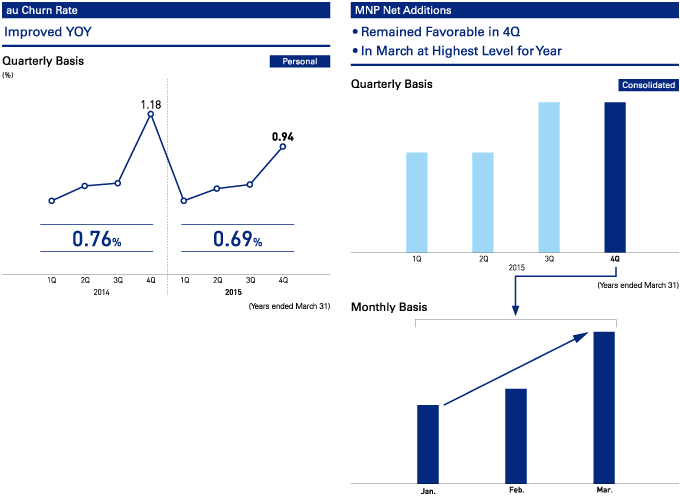
At KDDI, 50% of au smartphone subscribers and 60% of "au HIKARI" (FTTH) subscribers subscribe to "au Smart Value" (bundled services), which have a low churn rate. From this robust customer base and through sales measures utilizing our sales channels for mobile and fixed-line communications, we will continue to maintain and augment our competitiveness.
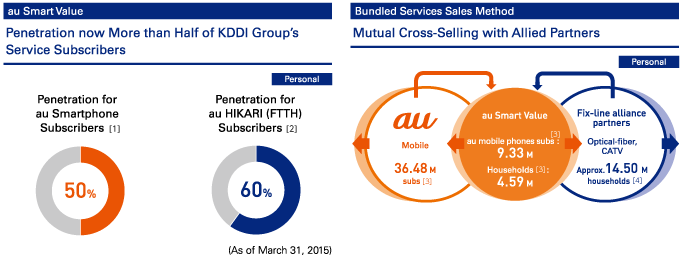
Introducing New Rate Plans
In the fiscal year ended March 31, 2015, each carrier expanded their selections of data usage plans in response to the growing number of smartphone users, aiming to bolster revenues to match growing data traffic per smartphone with new "flat-rate voice + tiered data" plans. In August 2014, KDDI also introduced a new rate plan.
We also worked to encourage the shift to smartphones by offering smartphones designed especially for seniors and juniors, where smartphone usage is relatively low, and rate plans that are discounted more than typical plans.
02. Targeting the Next Growth Stage
As we worked to maintain momentum in the mobile business and achieve steady earnings growth, we positioned the fiscal year ended March 31, 2015, as a year for "targeting the next growth stage". In Japan, we pursued the pillars of our "3M Strategy" (multi-network, multi-device, multi-use) for domestic business. As part of our "Global Strategy", we undertook such initiatives as commencing "telecommunications business in Myanmar".

Expanding au ARPA by Promoting Multi-Device Services
Since we announced our "3M Strategy," au ARPU has risen in tandem with the migration from feature phones to smartphones, and we have boosted mobile communications revenues by increasing the number of subscriptions (IDs) to bundled sets of fixed-line and mobile services.
Meanwhile, in the fiscal year ended March 31, 2015, we made a major move to promote multi-device services. Thanks to a sales campaign bundling smartphones and tablets, as of March 31, 2015, our cumulative number of tablet customers had risen to 2.5 times the level one year earlier.
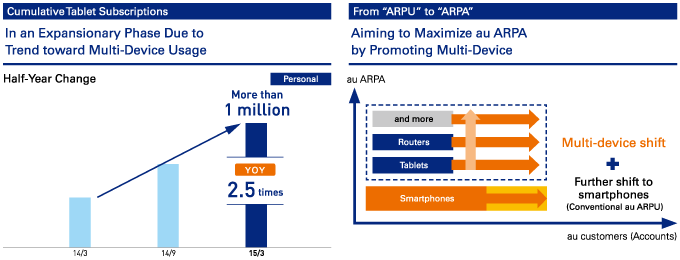
As part of this full-fledged promotion of multi-device services, we changed one of our KPIs that had been based on mobile services―au ARPU. We adopted the measure of "au average revenue per account (ARPA)", which reflects tablet and other multi-device revenues.
Going forward, by further promotion of our multi-device services we aim to expand revenues per customer rather than revenues per device.
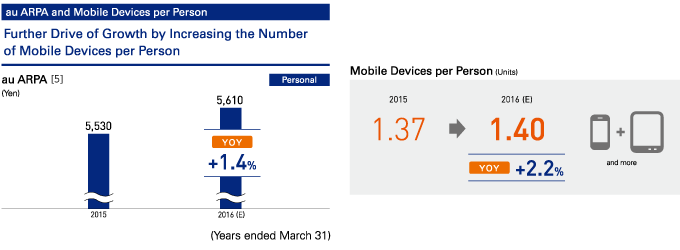
Expanding Value ARPA by Promoting Multi-Use
KDDI is moving aggressively to expand value-added revenues in non-communications domains by promoting the "multiuse" of the 3M strategy. Our focus going forward will be on further augmenting "value-added ARPA," or value-added sales per au customer. In Japan, carrier billing has gained traction as a settlement method for mobile content services. To date, we have leveraged this settlement platform by encouraging an expansion in "au Smart Pass" subscribers, centered on valueadded sales of online services. In addition to generating valueadded sales, "au Smart Pass" plays an important role in providing a contact point with customers that is instrumental in upselling services offering unlimited access to music, movies, e-books, and other content. As of March 31, 2015, the number of "au Smart Pass" members had risen to 12.89 million, and value-added sales had grown to ¥124.9 billion.
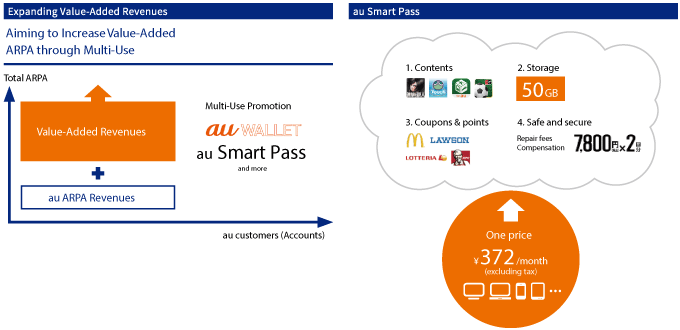
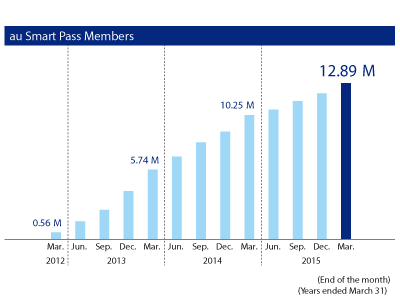
In addition to "au Smart Pass" and other online services, on May 21, 2014, we launched the "au WALLET" service―a new settlement platform for generating value-added sales of offline services. "au WALLET" is a prepaid e-money card that makes use of "au ID," an authentication key, to access various au network services, and provides a settlement function that allows for use at physical shops as well.
A tie-up with MasterCard (R) means that "au WALLET" can be used at approximately 38.1 million stores worldwide. Also, because of its link to carrier billing, charging is convenient. By quickly increasing the penetration rate among au customers and establishing "au WALLET" as a settlement platform for offline services, we aim for the transaction volume of our two major settlement platforms―"au Simple Payment" (carrier billing) and "au WALLET"―to reach ¥1 trillion by the fiscal year ending March 31, 2017.
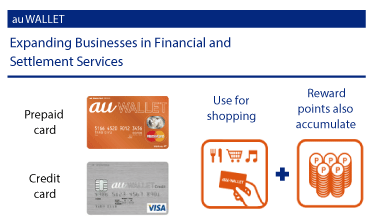
Promoting Our Global Strategy
Simultaneous to expanding the "au economic zone" in our domestic business, we are concentrating on another pillar of our growth strategy for the future: global business. In this category, we have signed a joint business agreement with Myanma Posts & Telecommunications (MPT) and are commencing the telecommunications business in Myanmar.
In Myanmar, we are increasing communications quality and extending the service area in key cities. We are also expanding call centers and making other moves to fortify our base for the communications business. Efforts to attract customers through various promotions and enhancing sales channels are steadily bearing fruit. In the seven months since we began joint business with MPT in September 2014, cumulative sales of SIM cards exceeded 8 million.
In addition to contributing to the development of Myanmar's economy and industry, as well as to the lives of the country's citizens, we are building these operations into a pillar of our growth strategy.

03. Cash Flow Allocation and Shareholder Returns
Capital Expenditures and Free Cash Flows
Capital expenditures during the fiscal year ended March 31, 2015, were essentially in line with our plans, at ¥576.2 billion, up 0.8% from the fiscal year ended March 31,2014. In addition to ongoing investment to expand our LTE service area and enhance communications quality, we invested in Jupiter Telecommunications Co., Ltd. (J:COM), which was included in the scope of consolidation in the fiscal year ended March 31, 2014, and in our data center business, which is performing favorably.
In the fiscal year ending March 31, 2016, we forecast capital expenditures totaling ¥600.0 billion. This includes ¥65.0 billion from the impact of including UQ Communications Inc. in the scope of consolidation associated with our planned transition to International Financial Reporting Standards (IFRS). As we have completed the process of configuring the LTE area to some degree, excluding the impact of the UQ consolidation we are planning a year-on-year decrease in capital expenditures.
Free cash flows for the fiscal year ended March 31, 2015, amounted to ¥287.7 billion, up ¥61.8 billion from the previous year's level, attributable to the rise in EBITDA. We expect to continue generating cash on a stable basis in line with income expansion, and intend to aggressively invest these funds in growth areas (M&As) to generate new growth.
Policy on Shareholder Returns
We plan to continue increasing our returns to shareholders, which focus on augmenting earnings per share (EPS) through sustainable growth and our commitment to raising dividends to meet our commitment of a dividend payout ratio in excess of 30%. The dividend for the fiscal year ended March 31, 2015, amounted to ¥170 [6] per share, up ¥40 from the previous year. This figure amounted to a consolidated dividend payout ratio of 33.2% and represented the 13th consecutive fiscal year of dividend increases. In the fiscal year ending March 31, 2016, the final year of our current medium-term management targets, we remain committed to a consolidated dividend payout ratio of more than 30%, and expect to raise dividends steadily as we achieve a synergy with higher EPS as income rises.
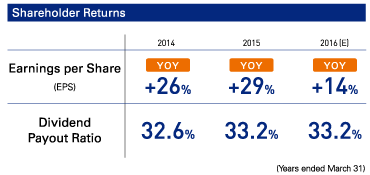
04. Introducing IFRS
The KDDI Group has decided to adopt International Financial Reporting Standards (IFRS) from the fiscal year ending March 31, 2016. We believe that this move will make our financial reporting more internationally comparable as we expand our global business, as well as making the financial information we provide more useful to investors and other stakeholders.

05. The Importance of the KDDI Group Philosophy as the Basis of Our Conduct as a Corporate Citizen
In the "KDDI Group Philosophy", KDDI describes the perspectives that employees should share and expresses a code of conduct. Respecting the individual characters of each of our employees goes without saying, but company management cannot work smoothly if employees have disparate visions and senses of ethics.
As a company that provides social infrastructure, our societal mission is to deliver stable telecommunications services regardless of conditions. As our business derives from utilizing radio waves―an important asset shared by all citizens―we must do our utmost to fulfill our attendant responsibilities by uniting the hearts of our employees and behaving as one.
Aiming for human welfare as well as the development of society, on a daily basis we think what value we can provide to society as individuals or as a corporate citizen. The KDDI Group Philosophy is the framework for sharing this value and strengthening trust. I see this as the essence of CSR management.
06. In Closing
The fiscal year ending March 31, 2016, will be the last of the three years for which I made a public pledge to meet our medium-term management targets, one of which was to post double-digit growth in consolidated operating income. This will be the year when we put in place the pillars for the next growth stage.
To respond quickly to changes in our operating environment, achieve sustained growth, and remain at the forefront of change, we will further entrench our growth strategies: the "3M Strategy" and the "Global Strategy." We will also strive to provide highly reliable networks, as well as high-valueadded products and services. In these ways, we intend to enhance corporate value even further.
- Other IR Information
- Recommended Contents
-




